VX Overview {LEGACY PRODUCT}
VX is the world’s first VoIP (Voice over IP) talkshow system — a broadcast phone system that’s so powerful it can run all of the on-air phones for your entire plant, but economical enough for stations with just two or three studios. VX connects to traditional POTS and ISDN telephone lines via standard Telco gateways. But it also connects to VoIP-based PBX systems and SIP Trunking services to take advantage of low-cost Internet-delivered phone services.
VX also weds modern networking to the remarkable power of digital signal processing. VX uses Ethernet as its connection backbone, significantly cutting the cost of phone system installation, maintenance and cabling. Ethernet is a powerful, yet simple way to share phone lines among studios and connect system components. This also makes VX naturally scalable, capable of serving even the largest of facilities — while remaining surprisingly cost-effective for even single stations with more modest needs.
Don’t have an IP-Audio network yet? No problem; optional Telos Alliance xNodes, like the Telos Alliance Mixed Signal Node, break out audio into analog and digital formats, along with GPIO logic commands.
VX Features {LEGACY PRODUCT}
-
World’s first VoIP telephone system designed and built specifically for broadcasting.
-
Standards-based SIP/IP interface integrates with most VoIP-based PBX systems to allow transfers, line-sharing and common telco services for business and studio phones.
-
Standard Ethernet backbone provides a common transport path for both studio audio and telecom needs, resulting in cost savings and a simplified studio infrastructure. Connection of up to 100 control devices (software or hardware) is possible.
-
Modular, scalable system can be easily expanded to manage a network of up to 20 studios, each with a dedicated Program-On-Hold input – truly a “whole-plant” solution for on-air phones.
-
System capacity of up to 48 standard phone lines; supports up to 250 SIP numbers.
-
Up to 24 hybrids, depending on ultimate system configuration.
-
Each call receives a dedicated hybrid for unmatched clarity and superior conferencing.
-
Native Livewire® integration: One connection integrates caller audio, program-on-hold, mix-minus, and logic directly into Axia AoIP consoles and networks.
-
Connect VX to any radio console or other broadcast equipment using available Telos Alliance AES/EBU, Mixed Signal, and GPIO xNodes. Audio interfaces feature 48 kHz sampling rate and studio-grade 24-bit A/D converters with 256x oversampling.
-
Powerful dynamic line management enables instant re-allocation of call-in lines to studios requiring increased capacity.
-
VSet phone controllers with full-color LCD displays and Telos® Status Symbols present producers and talent with a rich graphical information display. Each VSet features its own address book and call log.
-
Drop-in modules can integrate VX phone control directly into your Axia mixing consoles.
-
Included XScreen screening software with built-in soft-phone allows a “phone” connection on any networked PC. Integrated recorder/editor simplifies recording of off-air conversations.
-
Clear, clean caller audio from fifth-generation Telos Adaptive Hybrid technology, including Digital Dynamic EQ, AGC, adjustable caller ducking, and send- and receive-audio dynamics processing by Omnia®.
-
Wideband acoustic echo cancellation from Fraunhofer IIS completely eliminates open-speaker feedback.
-
Support for G.722 codec enables high-fidelity phone calls from SIP clients.
- Works with POTS, T1/E1, ISDN and SIP Trunking telco services for maximum flexibility and cost savings, via standard Telco gateways.*
* Due to the wide variation in how traditional phone service can be delivered, and the complexities that can be involved in converting those services to SIP, we really want to talk with you about your system design before you order. Telos has VX System engineers standing by to help you draw up a configuration that will ensure your VX purchase will perform to your expectations when using traditional POTS and ISDN lines.
VX In Depth {LEGACY PRODUCT}
VoIP for Broadcast. From Telos, Naturally.
VX is the world’s first VoIP (Voice over IP) talkshow system. It’s incredibly powerful, very flexible, and highly scalable — a powerful whole-plant broadcast phone system that’s also economical enough for stations with just two or three studios.
VoIP has already taken the business world by storm, increasing the flexibility of office phone systems and PBXs while simultaneously lowering maintenance and equipment costs. In fact, most Fortune 500 companies have replaced their older PBX systems with VoIP for just these reasons. There’s no reason broadcasters shouldn’t take advantage of this cost-saving technology as well.
Sure, VX can connect to traditional POTS and ISDN telephone lines using standard Telco gateways. But we’ve built VX around the VoIP standard, so that it can connect natively to VoIP-based PBX systems
and modern SIP Trunking services, allowing you to take advantage of low-cost Internet-delivered phone services. In addition to cost savings from digital phone service provisioning, VX significantly eases the cost of installation, maintenance and cabling by using standard Ethernet as its data backbone.
As a result VX is naturally scalable, capable of serving even the largest of facilities — while remaining surprisingly cost-effective for even single stations with more modest needs. There are major operational benefits as well. VX combines the flexibility and economy of modern SIP networking with powerful digital signal and audio processing — making it easier than ever for talent to take control of their phone system. You can move and share lines between studios at the touch of a button. VX is truly the future of broadcast phones.
Why VoIP for broadcast?
VoIP is a natural for broadcasters. Using VoIP, you can interconnect the phone system CPU with audio interfaces, phone sets, console controllers, and PCs running screening software using efficient, low-cost Ethernet. You can finally share phone lines among multiple studios and route caller audio anywhere in your facility, easily and instantly. Got a hot talkshow that suddenly needs more lines in a certain studio? Just a few keystrokes at a computer and you’re ready — no delays, and no cables to pull. VX can even connect with your business office’s VoIP PBX to facilitate easy call transfers.
Of course, it’s got to sound good. And it does, thanks to more than two decades of DSP hybrid technology developed by Telos. Every incoming line has its own fifth-generation digital hybrid, our most advanced ever, packed full of technology engineered to extract the cleanest, clearest caller audio from any phone line — even noisy cellular calls. Multiple lines can be conferenced with superior clarity and fidelity. Smart AGC ensures consistent caller audio levels. New Acoustic Echo Cancellation from FhG removes feedback and echo in open-speaker studio situations. And if you choose to use SIP Trunking telco services, calls from mobile handsets with SIP clients will benefit from VX’s native support of the G.722 codec, instantly improving caller speech quality.
Since VX uses Ethernet as its network backbone, it naturally plugs right into Axia IP-Audio networks, connecting multiple channels of audio and control using a single Ethernet cable. If you don't have an IP-Audio network yet, that's OK; Telos Alliance xNodes provide AES audio and GPIO connections that work with your existing studio equipment.
VX COMPONENTS
The VX Engine
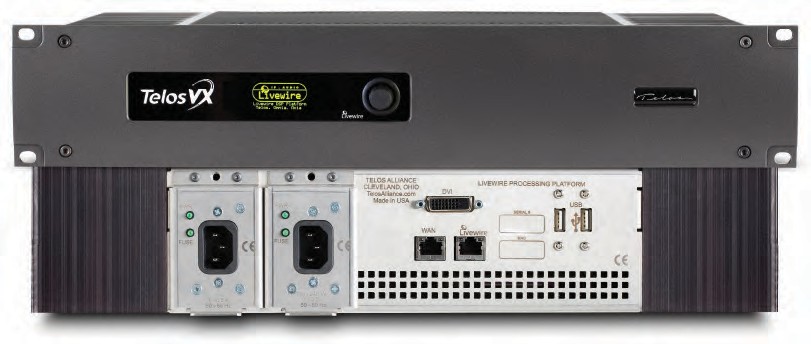
The VX Engine, a fan-free 2RU rack-mount device with enormous processing power, is the heart of the system. It provides all the call control and audio processing needed for the system, and supports up to 30 active calls on-air simultaneously, across as many as 20 studios. Its two Gigabit Ethernet ports provide a cost-effective interface to both telephone lines and studio audio via proven Livewire AoIP. VX is Web-based, so remote control and configuration are a snap — engineers can work with it from any place they can get online.
Call processing is sophisticated and flexible. Lines may be readily shared among studios; the Web interface allows easy assignment of lines to “shows”, which can then be selected by users on the studio controllers. Each studio can provide its own Program-on-Hold audio to callers.
Audio processing features also have taken a leap forward. The processing power of the VX Engine allows multiple calls to be conferenced and aired simultaneously, with excellent quality. The hybrids are equipped with a rich toolbox to make caller audio sound its best, no matter what kind of line or phone the caller uses. Caller audio benefits from Smart AGC coupled with famous Telos three-band adaptive Digital Dynamic EQ and a three-band adaptive spectral processor. Send audio gets its own sweetening with a frequency shifter, AGC/limiter, and FhG’s Advanced Echo Cancellation technology that literally eliminates open-mic feedback. Call ducking and host override are part of the VX toolkit as well, and
talent can manage and customize their telephone settings and workflow using VX Show Profiles to store and recall commonly used show configurations.
You’ll notice that there are no audio I/O or telco ports on the VX Engine. All connections to the Engine are via the two Ethernet jacks that connect to your system’s Ethernet switch to support a wide variety of peripherals: telephone lines, Livewire studio audio, VSet phones, VX Producer PC applications, console- integrated controllers, etc.
For traditional phone services, you can choose standard telco gateways from Asterisk, Patton, Cisco, Grandstream, and others to connect to T1/E1, ISDN, and POTS providers. And, if you have a VoIP-based PBX or SIP Trunking telco service, the VX uses standard SIP (Session Initiation Protocol) and RTP (Real- time Transport Protocol).
The Coolest Broadcast Phone Controllers Ever.
With decades of experience designing broadcast phone systems, it’s no wonder broadcasters agree that Telos makes the industry’s most powerful, most flexible system controllers. All VSet phones can be powered by PoE from a Telos-approved switch, a PoE port on an Axia console engine, or by using the included power injector.
VSet12
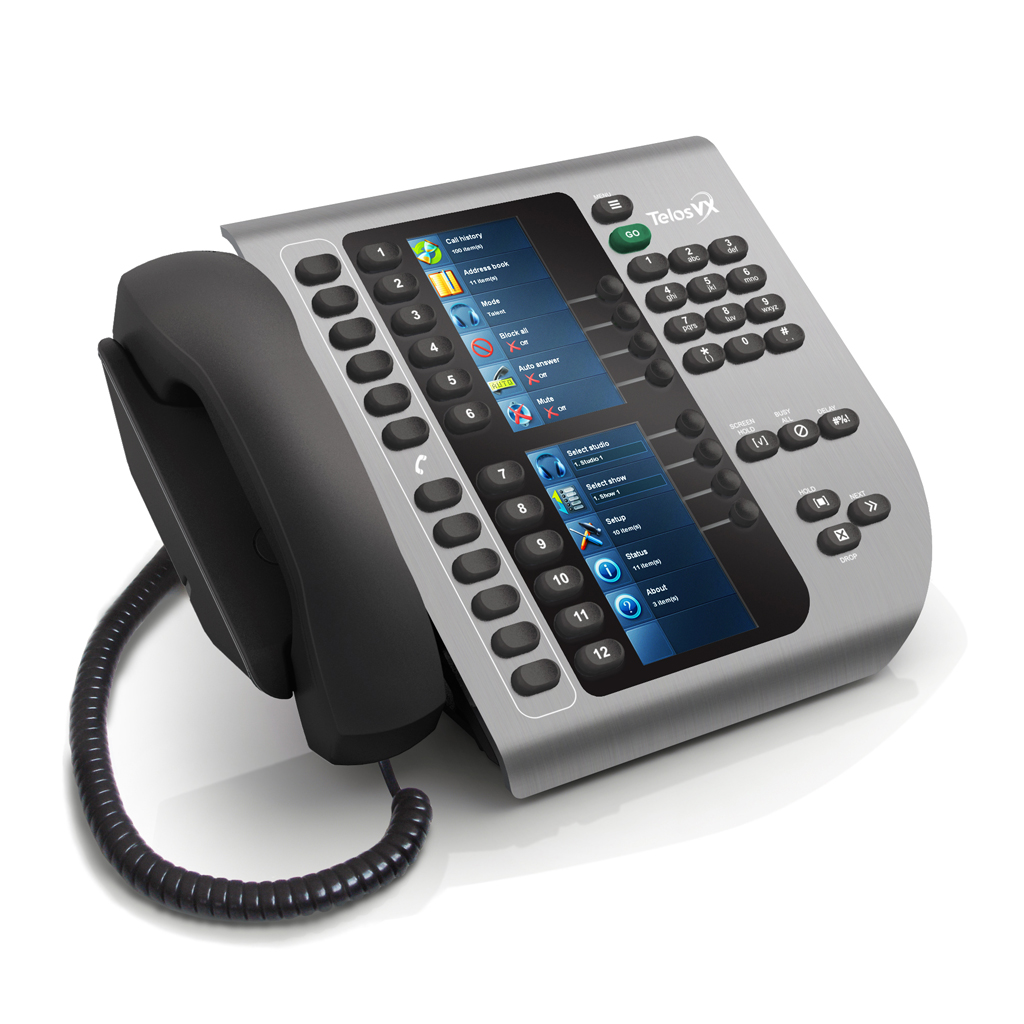
The VSet12 phone controller is an IP-based phone set with two large, high-contrast color LCD panels that provide line status and caller information. VSet phones can work like a traditional Telos controller, with calls being selected, held, and dropped in the way to which operators have grown accustomed. But because the VX system is so powerful, much more functionality is unlocked: You can now spread multiple calls over a number of faders, using one for each call so that operators can control each line’s level individually. You can hard-assign individual lines to fixed faders, such as for VIP calls. You can even map groups of lines to a single fader.
VSet6
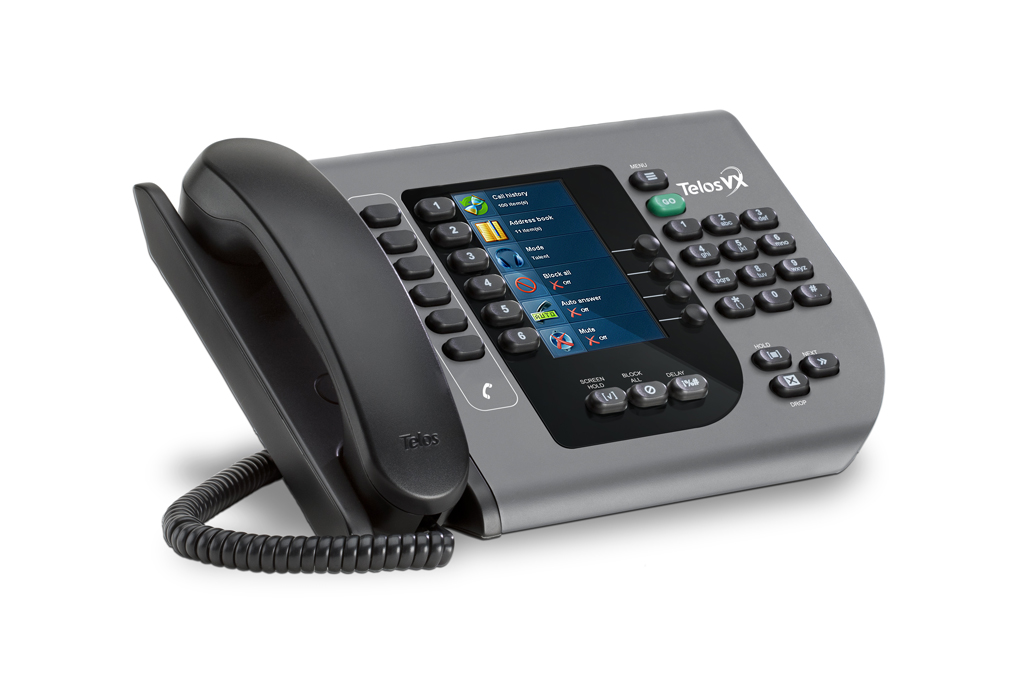
VSet6 is a six-line phone controller for VX. Like the VSet12, it has a bright, attractive LCD color display with Status Symbols that feed talent instant information about line and caller status, and controls that enable talent to step through queued calls, busy incoming lines, lock calls on-air, start an external recording device, et cetera. Next Call functionality speeds workflow for producers, screeners, and talent. With all the control functions of the VSet12, it’s great for smaller or secondary studios.
On-Console Control
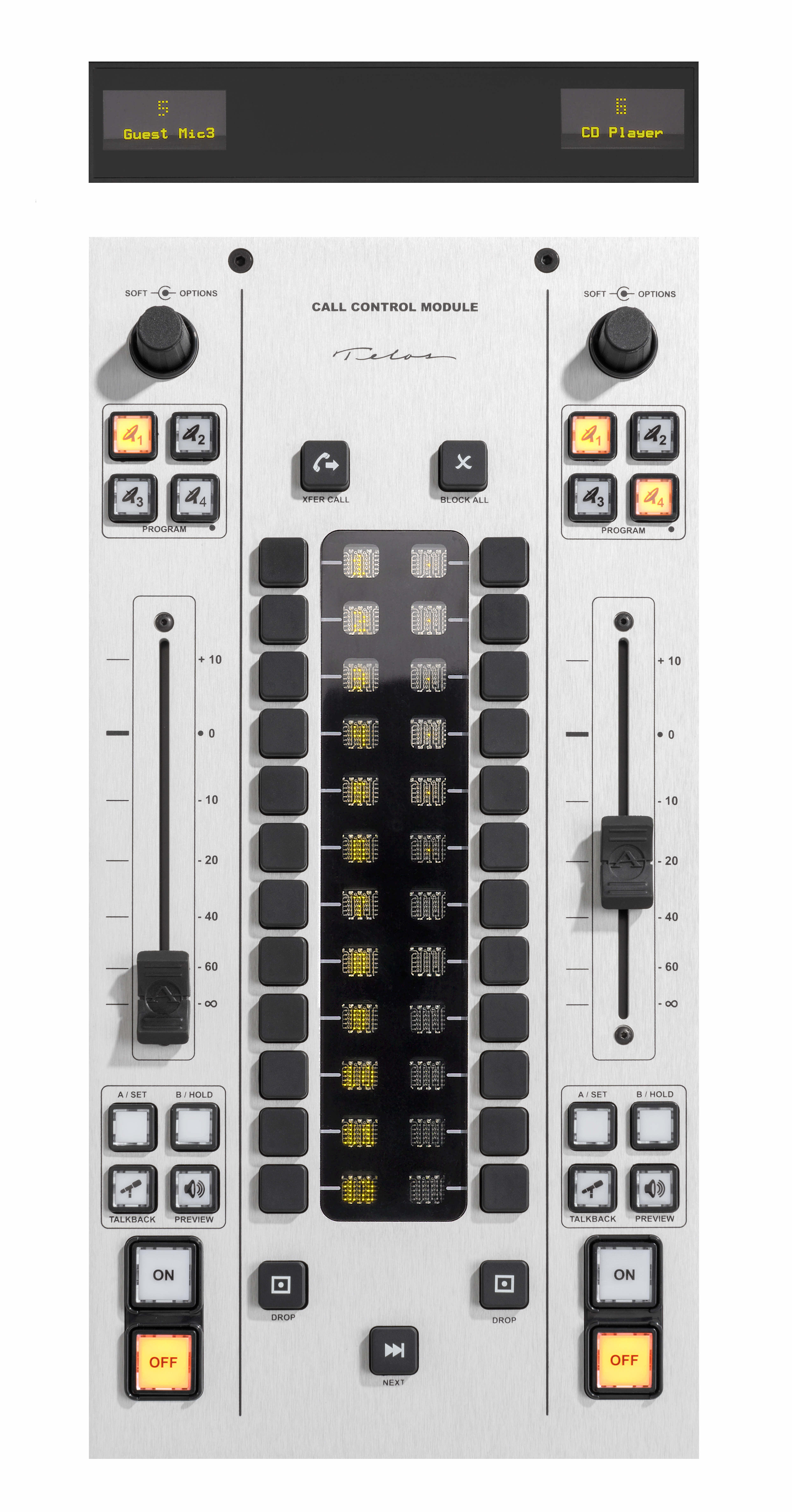
Live calls or pre-recorded, interviews or audience participation, one thing’s certain: Phone segments are an integral part of today’s fast-paced radio. But up to now, the phone system was separate from the on- air console; audio was shared, but little else. Wouldn’t it be great if talent could take control of phones without ever having to divert their attention from the board?
They can: IP-Audio networking technology provides the ideal way to integrate broadcast phones into the on-air console — the control center of every studio. VX connects directly to Axia mixing consoles using Livewire IP-Audio to eliminate the cost and complexity of old-style inputs, outputs, and mix-minuses. Multiple phone lines – each with a dedicated hybrid – can automatically map to individual console faders for complete control of caller audio. And users enjoy seamless console integration, with phone controls right on the board so that talent can dial, answer, screen, and drop calls without ever diverting their attention from the console. Information about line and caller status can be displayed right on the console as well.
There are plenty of other advantages to melding phones with consoles. Like ease of installation: IP- Audio consoles with built-in phone controllers don’t need any additional wires or connections. Their control signaling, caller audio, and backfeeds ride on the network connection that’s already there. Bringing caller audio into the IP-Audio domain makes it routable like any other audio source. With the Virtual Mixers built into Axia consoles, you could even choose to dynamically conference multiple lines and control their gain with a single fader. And since the console now communicates directly with the phone hybrid, mundane tasks such as mix-minus generation, starting recording devices, and playback of recorded off-air conversations can all be automated.
Audio Interfaces: Telos Alliance xNodes

Telos Alliance xNodes let you connect VX to any non-networked radio console or other broadcast equipment, using standard AES/EBU interfaces. A GPIO Logic xNode provides control logic where needed. To cover all your bases, the Telos Alliance Mixed Signal xNode provides one mic/line analog input (switchable); two analog line inputs (dedicated); three analog line outputs; one AES3 input, one AES3 output, and two GPIO ports, each with five opto-isolated ins and outs.
The Telos Alliance AES/EBU audio xNode 4 AES/EBU inputs and 4 AES/EBU outputs. Left and right input signals may be split and routed independently as mono signals. Stunning performance specs include 48kHz sampling rate, 126 dB of dynamic range, and <0.0003% THD.
Each Telos Alliance GPIO logic xNode interface provides six general-purpose logic ports with five opto-isolated inputs and five outputs. A logic port can be associated with any audio input or output and routes control data transparently along with the audio.
VSet Call Controller

Want a VX system, but don’t have an Axia mixing console? No problem—Telos provides VSet Console Controller electronics packages, which may be fitted to your console using panels supplied by your OEM console provider or preferred third-party fabricator. Like the VSet12 phoneset, the VSet Console Controller provides visual line-status indicators and fast-take keys for selection and control of up to 12 callers, along with standard controls such as Take, Drop, Hold and Busy keys, and the Telos-exclusive “Next Call” key to speed workflow for producers, screeners, and talent. There’s also a built-in keypad for on-console dialing of outgoing numbers.
Broadcast Bionics Xscreen Call-Screening Software Included
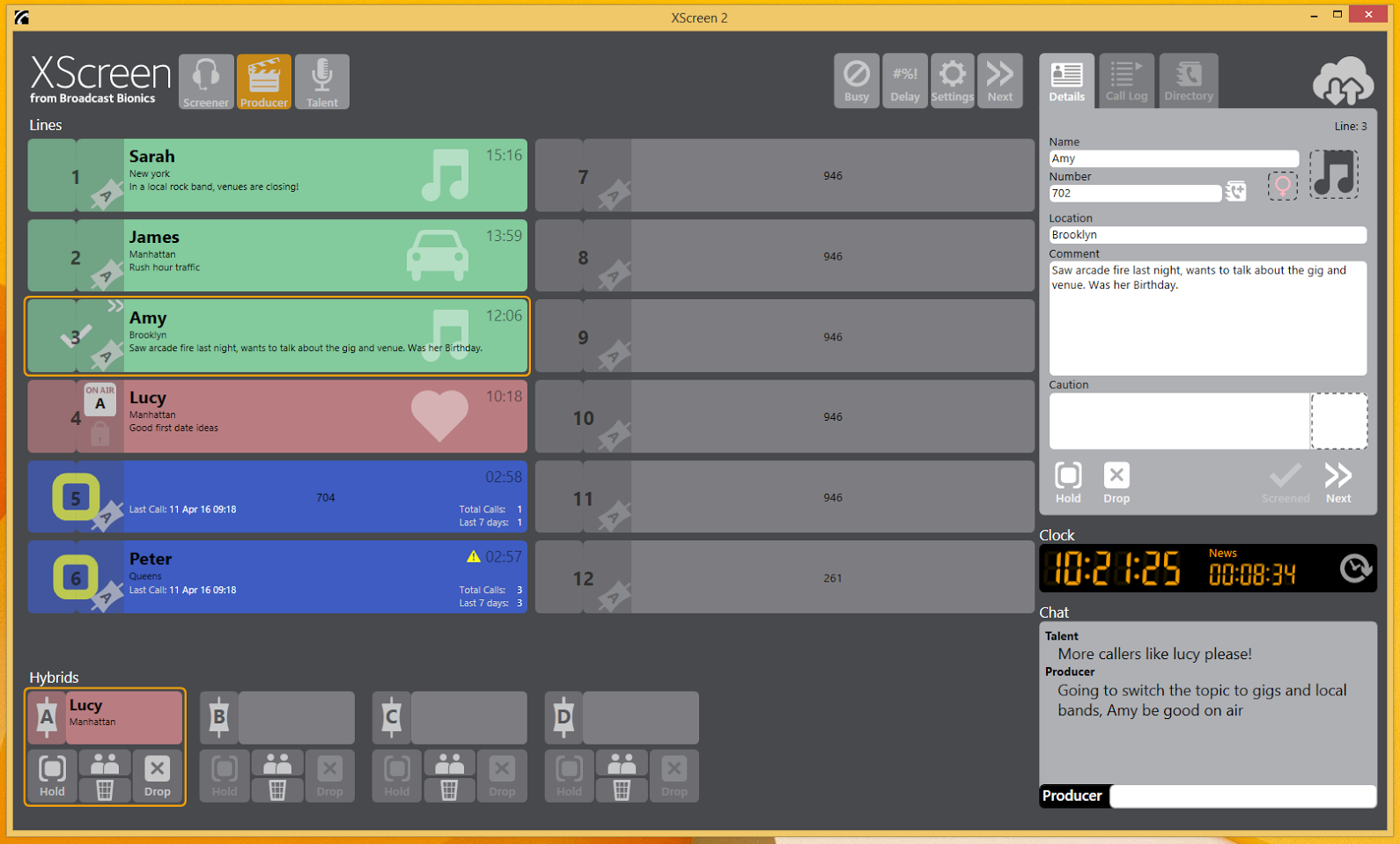
XScreen software comes with every VX Engine purchase and provides call control, call screening, data capture, and chat functionality enabling you to quickly answer, screen, and route calls using multiple PC clients. The cloud-based database keeps a log of calls and provides further alert and directory functionality.
XScreen can record and manage caller audio (Livewire systems only) and can additionally act as a softphone for talking to and screening callers directly through a USB headset or soundcard on your XScreen client PC.
XScreen is available in free (Lite) and full (subscription) versions. When you install XScreen for the first time you will receive a 90-day free trial license for the full version. After 90 days you can continue to use the full version with an annual subscription, or use the reduced, Lite functionality free of charge. Please download your XScreen software from www.xscreen2.com.
NeoGroupe
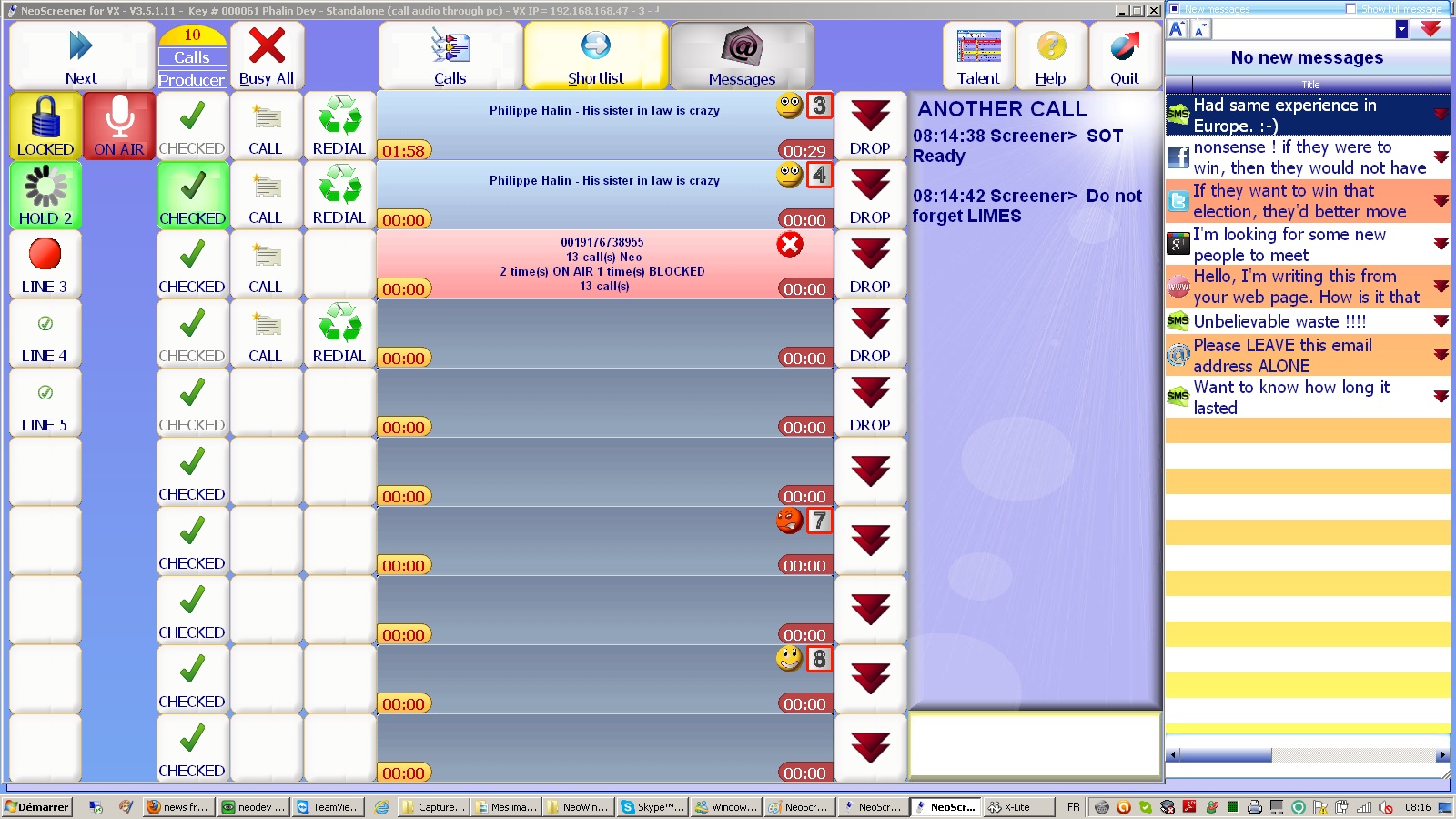
NeoGroupe offers NeoScreener, a call management solution that interfaces Telos NX12, NX6, IQ6, VX, HX6, 2x12 and 2101 systems, allowing for line control and database lookup using caller ID. The solution can interface to NeoWinners which is NeoGroupe’s contest management software. It is designed for radio and television stations that need to manage their flow of incoming phone calls.
NeoScreener also handles external inputs, like SMS, Website, iPhone. Database driven, it enhances the phone-call workflow. With NeoScreener, call screeners can easily welcome calls and present them to the Talent on a specific display. Visit www.neogroupe.com to learn more.
VX Specifications {LEGACY PRODUCT}
General
-
Telos 5th-generation Adaptive Digital Hybrids.
-
Maximum number of phone lines: 48, when used with a-Law or u-Law codecs for VoIP lines. (Higher quality codecs, such as G.722, consume more system resources and result in a decreased number of total lines available.)
-
Maximum number of SIP numbers: 250
-
Maximum active on-air calls: 48
-
Maximum on-air calls on one fader: 4
Analog Inputs (with Telos Alliance xNode):
-
Input Impedance: >40 k Ohms, balanced
-
Nominal Level Range: Selectable, +4 dBu or -10dBv
-
Input Headroom: 20 dB above nominal input
Analog Outputs (with Telos Alliance xNode):
-
Output Source Impedance: <50 Ohms balanced
-
Output Load Impedance: 600 Ohms, minimum
-
Nominal Output Level: +4 dBu
-
Maximum Output Level: +24 dBu
Digital Audio Inputs And Outputs
-
Reference Level: +4 dBu (-20 dB FSD)
-
Impedance: 110 Ohm, balanced (XLR)
-
Signal Format: AES-3 (AES/EBU)
-
AES-3 Input Compliance: 24-bit with selectable sample rate conversion, 32 kHz to 96kHz input sample rate capable.
-
AES-3 Output Compliance: 24-bit Digital Reference: Internal (network timebase) or external reference 48 kHz, +/- 2 ppm
-
Internal Sampling Rate: 48 kHz
-
Output Sample Rate: 44.1 kHz or 48 kHz
-
A/D Conversions: 24-bit, Delta-Sigma, 256x oversampling
-
D/A Conversions: 24-bit, Delta-Sigma, 256x oversampling
-
Latency <3 ms, mic in to monitor out, including network and processor loop
Frequency Response
-
Any input to any output: +0.5 / -0.5 dB, 20 Hz to 20 kHz
Dynamic Range
-
Analog Input to Analog Output: 102 dB referenced to 0 dBFS, 105 dB “A” weighted to 0 dBFS
-
Analog Input to Digital Output: 105 dB referenced to 0 dBFS
-
Digital Input to Analog Output: 103 dB referenced to 0 dBFS, 106 dB “A” weighted
-
Digital Input to Digital Output: 138 dB
Total Harmonic Distortion + Noise
-
Analog Input to Analog Output: <0.008%, 1 kHz, +18 dBu input, +18 dBu output
-
Digital Input to Digital Output: <0.0003%, 1 kHz, -20 dBFS
-
Digital Input to Analog Output: <0.005%, 1 kHz, -6 dBFS input, +18 dBu output
Crosstalk Isolation, Stereo Separation and CMRR
-
Analog Line channel to channel isolation: 90 dB isolation minimum, 20 Hz to 20 kHz
-
Analog Line Stereo separation: 85 dB isolation minimum, 20Hz to 20 kHz
-
Analog Line Input CMRR: >60 dB, 20 Hz to 20 kHz
VX engine
IP/Ethernet Connections
-
One 100BaseT/gigabit Ethernet via RJ-45 LAN connection
-
One 100BaseT/gigabit Ethernet via RJ-45 WAN connection
Processing Functions
-
All processing is performed at 32-bit floating-point resolution.
-
Send AGC/limiter
-
Send filter
-
Gated Receive AGC
-
Receive filter
-
Receive dynamic EQ
-
Ducker
-
Sample rate converter
-
Line Echo Canceller (hybrid)
-
Acoustic Echo Canceller (wideband)
Power Supply AC Input
-
Modular, field-replacable auto-sensing supply, 90VAC to 240VAC, 50 Hz to 60 Hz, IEC receptacle, internal fuse
-
Power consumption: 100 Watts
Operating Temperatures
-
-10 degree C to +40 degree C, <90% humidity, no condensation
Studio Audio Connections
-
Via Livewire+ IP/Ethernet. Each selectable group and fixed line has a send and receive input/output.
-
Each studio has a Program-on-Hold input.
-
Each Acoustic Echo Canceller has two inputs (signal and reference) and one output.
-
Livewire+ equipped studios may take the audio directly from the network. Telos Alliance xNodes are available for pro analog and AES3 breakout.
Telco Connections
-
Audio: standard RTP. Codecs: g.711u-Law and A-Law, and g.722
-
Control: standard SIP trunking
Regulatory
-
Click here to view the current regulatory compliance
























































